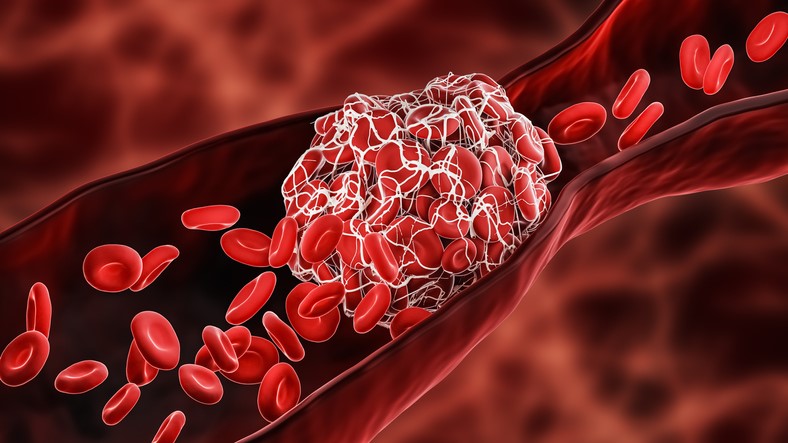Pulmonary embolism [PE] occurs when there is a blockage in one of the pulmonary arteries in your lungs, which occurs when a blood clot [thrombus] travels to the lungs from deep veins in the legs or, rarely, from veins in other parts of the body. In medical terms, this condition is referred to as deep vein thrombosis [DVT]. When blood clots block the flow of blood to the lungs, a pulmonary embolism can be life-threatening. Taking measures to prevent blood clots in your legs will help protect you against pulmonary embolism, and if clots do occur prompt medical treatment greatly reduces the risk of death.
A significant factor in the development of a pulmonary embolism is immobility which inhibits the calf muscles in your legs from from contracting. The reason being that a deep vein thrombus [DVT] may form because the circulation of blood slows down or stops. When this happens, there is a tendency for the blood to accumulate or “pool” creating an ideal environment for clot formation and the development of DVT.
Some of the causes of DVT are trauma to the leg, inflammation due to infection, damage to a vein in the course medical procedure, bed rest during a long hospital stay, recuperating from an injury, surgery or illness. In fact, just sitting for long periods of time, such as when flying or driving may can be causing blood clots to form in the calf of your leg(s).When a person is sedentary, especially if they have other risk factors, a DVT may form because the circulation of the blood slows down or stop [stasis].
SIGNS AND SYMPTOMS OF A DVT
- Swelling in the leg
- Pain, cramping of soreness in the leg that starts in the calf
- Red or discolored skin on the leg
- Feeling warmth on the affected leg
RISK FACTORS FOR DEVELOPING A DVT
- Hypertension [high blood pressure]
- Age 60 years of age or older
- Being overweight or obese causing pressure on the veins, pelvis and legs
- Smoking which affects blood clotting and circulation
WARNING SIGNS OF A PULMONARY EMBOLISM:
- Chest pain or discomfort when taking a deep breath or coughing
- Sudden shortness of breath
- Feeling lightheaded, dizzy or felling faint
- Rapid pulse
- Rapid breathing
- Coughing up blood
RECOGNIZING SYMPTOMS
Good and accepted medical practice requires that a physician and hospital staff remain alert to these elevated risk factors that can, and do, lead to the development of DVT, especially in a patient who meets multiple criteria. Recognizing symptoms and timely intervention is critical in preventing a pulmonary embolism. The best strategy against DVT is to prevent it from developing in the first place. There are a number of effective ways that prevention can be accomplished. Proper instructions must be given to the patient. Instructing the patient that active movement is required by wiggling the toes and/or flexing the ankles for 5 minutes every hour is effective. While elevating the leg is helpful, the patient must carefully be instructed to avoid compression of the calf when the leg is elevated. Compression stockings [special knee socks]reduce the chances that your blood will pool and clot. Further instructions that you drink sufficient amounts of water to remain hydrated is also effective in preventing DVT and pulmonary embolism.
TREATMENT OPTIONS
In the course of a hospital admission, a venogram [an x-ray with dye] can be performed to adequately assess the deep veins within the leg. The three main goals of DVT treatment are (1) preventing the clot form getting bigger, (2) preventing the clot form breaking loose and traveling to the lungs and causing a pulmonary embolism, and (3) reducing the chances of another DVT. Initially, blood thinners [anticoagulants] taken by mouth, injections or intravenously are used to prevent the clots from getting bigger. Clot buster drugs [thrombolytics] are called for with more severe types of DVT or pulmonary embolism, which are given by intravenously or through a catheter of directly into the clot. In some cases, a vena cava filter is inserted into a large vein in the abdomen to prevent clots from lodging in the lungs.
Sanocki Newman & Turret, LLP has been successful in handling cases involving people who have had devastating or fatal injuries due to the carelessness of a physician, hospital or other health care provider in failing to promptly diagnose and treat a patient suffering from deep vein thrombosis which may ultimately progress to a pulmonary embolism.
Should you have questions or require assistance, please call Sanocki Newman & Turret, LLP. (212) 962-1190.


